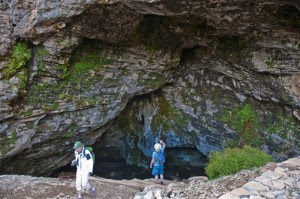The cradle of Zeus, the cave of Idaion Antro, has always been the reason for Psiloritis to be glorified & regarded as sacred
The stone giant of Crete, a natural border between the Earth and the
Sky, dominates the whole of the island. Mountainous villages perched on
the edge of a precipice; caves of unique beauty; impressing karstic
formations; gorges in thick shade; plateaus and alpine areas; all that
and many more make up the unbeatable scenery.
The mountain chain of Idi, also known as Psiloritis, unveils all the
beauty of Crete under its snow-capped peaks: the White Mountains in the
west; Mount Dikti in the east; the plain of Messara, the Asteroussia
Mountains and the Libyan Sea in the south; Herakeion and Rethymno in the
north.
In the Doric atmosphere of this rugged land, proud, dashing and
strong men are bred to farm for a living and search for the real meaning
of life in the simplicity and wisdom of nature.
Nature’s gifts
According to Herodotus, Psilorits was once covered by thick forests
where all the endemic Cretan species used to live.
The largest one of
the few surviving forests is situated at Gergeri near Herakleion; it is
the oak forest of Rouvas, home to the rare species of the local flora
and fauna, such as the Cretan wild cat. Smaller forests are situated on
the plateau of Vromonero, at Kroussonas near Herakleion, and at Zaros
and Pardi, near Rethymno.
The non-forested peaks are ruled by birds of
prey such as the bearded vulture, the golden eagle, the falcon, and the
royal eagle.
In 2001 the Psiloritis Geopark was founded and it is now part of the
network of UNESCO Geoparks. Hiking on the mountain equals an ecological
and geological delight in the heart of an awesome landscape.
At the shrubby foot of the mountain bloom iris and crocus flowers,
along with other wild ones, that have been decorating the land of Crete
since the Minoan years. Among the wonders of nature, let us mention the
springs at Spili, Lake Votomos at Zaros, the gorges of Agios Nikolaos,
of Vorizia, and of Almyros.
Last but not least, at the area of Zoniana
there is one of the most significant caves in Greece with impressing
stalactites and stalagmites, named “tou Sfendoni i Trypa”.
Sightseeing
The cradle of Zeus, the father of Gods and humans, the cave of Idaion
Antro has always been the reason for Psiloritis to be glorified and
regarded as sacred.
The largest well-preserved Minoan mansion lies at
the archaeological site of Zominthos.
Christianity has left its mark
here too: on the peak of Timios Stavros (2.456m) the highest one of the
mountain chain, stands the stone church by the same name (meaning “Holy
Cross”).
Some more religious points of interest include the legendary
monastery of Arkadi, as well as those of Diskourio and Chalepa.
The road to the top!
Hiking to the top will be an arduous task, especially in the winter.
Take along your equipment and sufficient water supplies (no water
available after 1.500m) and brace yourselves for a long and difficult
walk.
The path E4 is the best marked one starting at the plateau of
Nida. Once on the peak of Timios Stavros, seek refuge in the church and
enjoy the breathtaking view.
Activities
The international event Psiloritis Race will be a perfect alternative
for those visiting the area next June.
What is more, you can do
mountaineering, caving/spelunking, paragliding, mountain biking, and
climbing, or opt for off road jeep fun.
Source: visitgreece.gr











